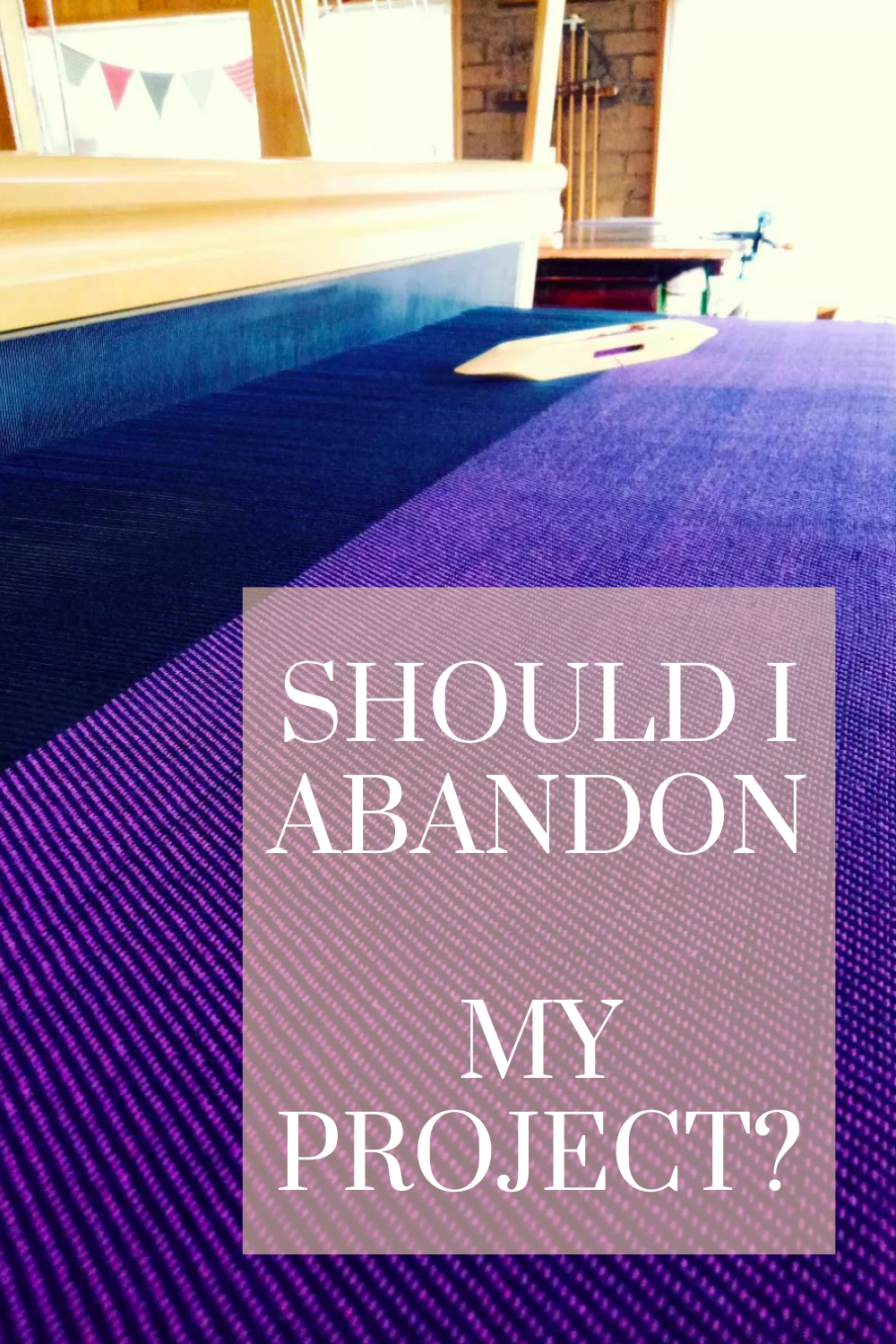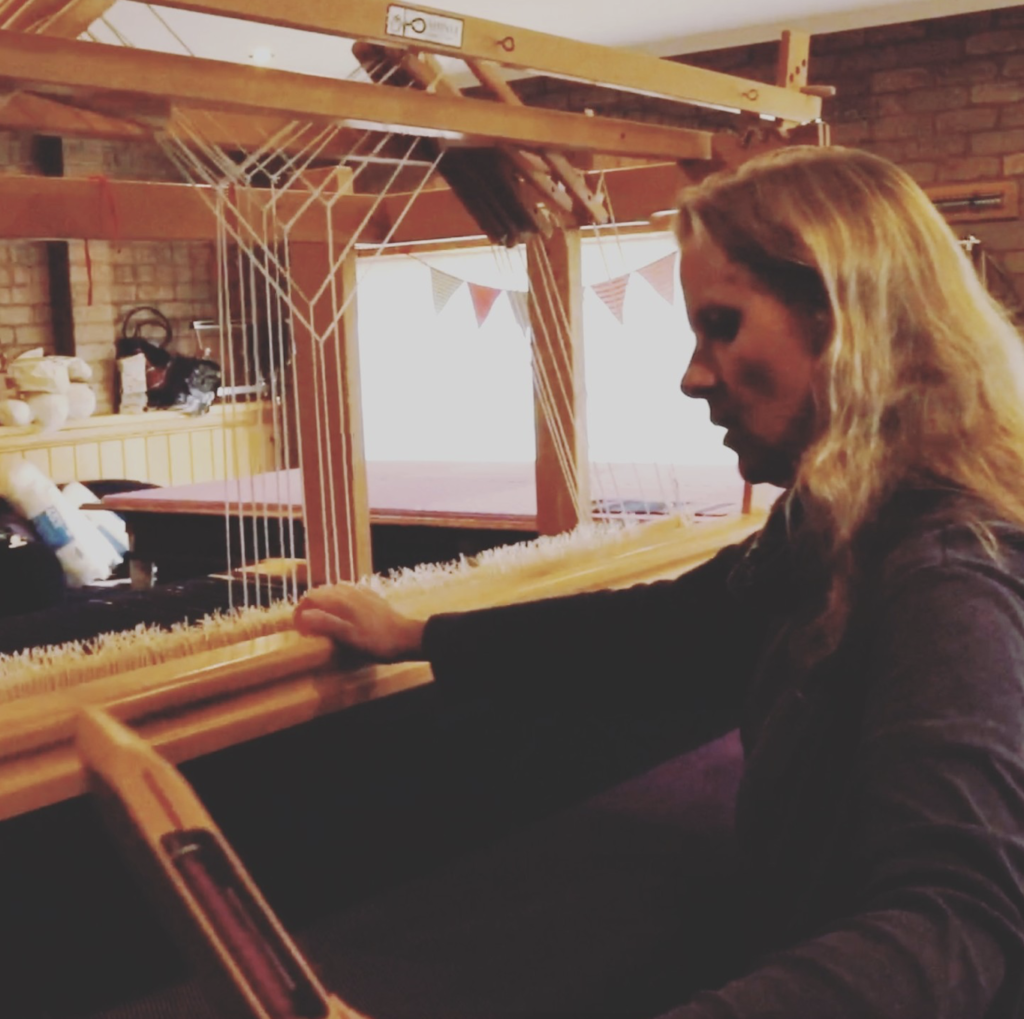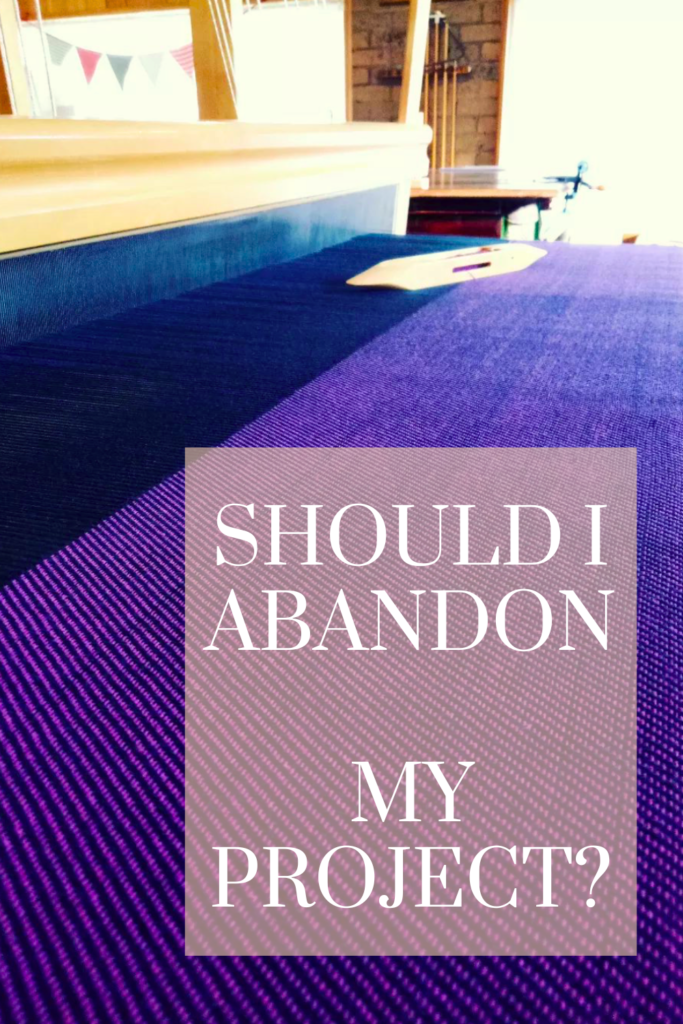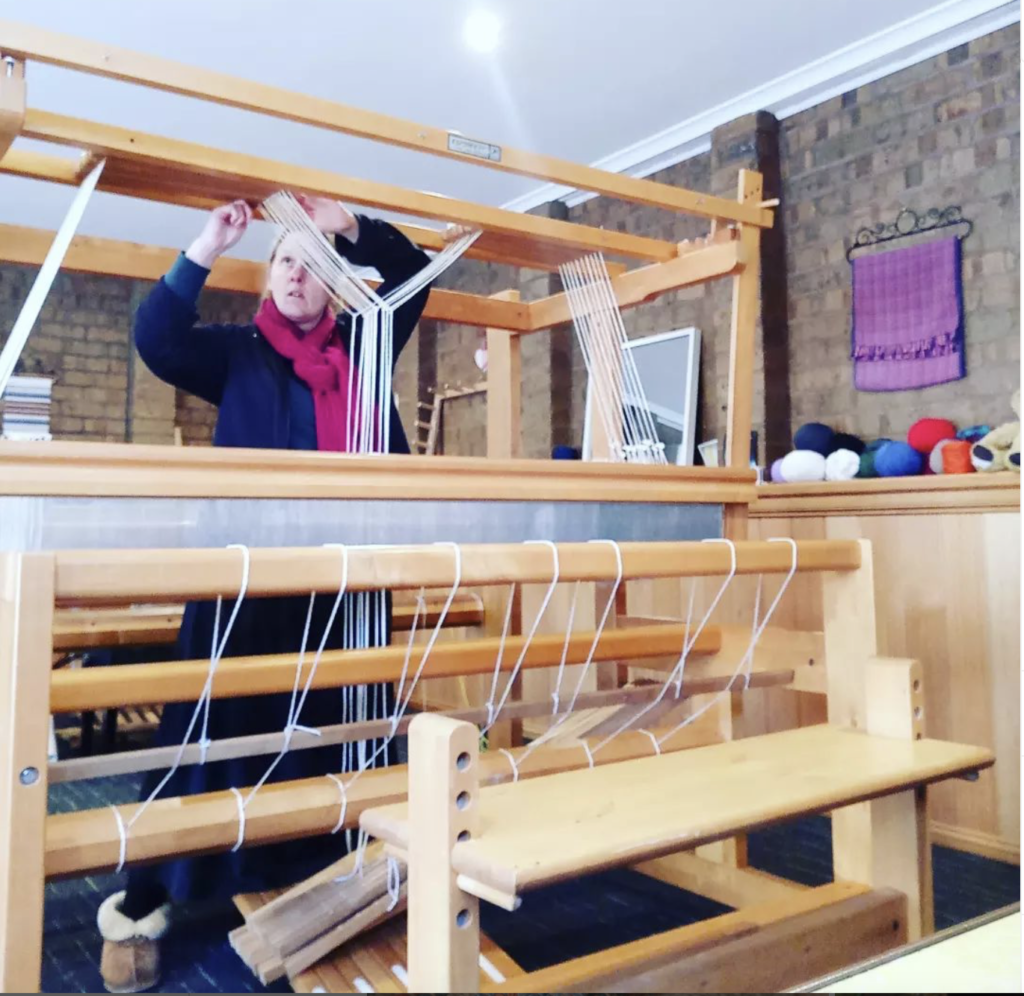The other day, I cut the warp off my loom way before I was finished the project.
But let me explain!
This project was literally months in the making, from dressing the loom (which I did in stages and just that step alone was worked on over weeks!) to tweaking the loom, to the actual weaving.
This was my first “big” project on my countermarch loom and I felt I was ready for it. I ordered the threads and made my plan – a full width warp (almost 60″), very long (I don’t even remember how many yards I initially put on), fairly fine threads and a 4 shaft, straight draw twill. The plan was to weave enough yardage for 2 skirts. I like long skirts, so wanted plenty of fabric.
So, what went wrong with this grand plan?
Probably too many things to include here, but here were the main issues:
- I warped at my warping board and then used the plain beam to warp. Given that it was such a long and wide warp, this was very difficult to do on my own and achieve a suitable tension.
- I discovered what weaving a wide warp is like. It’s harder than I thought. It put a lot of strain on my back, having to reach and shuffle across my weaving bench with every throw of the shuttle.
- My sheds were… not good! A result of my poorly tensioned warp.
- I really should have practiced more with the “new to me” countermarch loom before attempting a project of this magnitude.
It was just a struggle from the beginning and there were no real “ah” moments of settling in and getting into a happy weaving groove with it. It was mostly troubleshooting and battling.
I spent a lot of time at the loom, trying to work through it. I did not want to waste all that warp yarn I still had left.
But eventually it became too much, a built up stress in my mind and I took the scissors and cut the warp off.
PHEW! What a relief! At this stage, I have a little bit of useable fabric and no regrets for the wasted warp. I chalk it up to a learning experience, and boy, did I learn a lot!
I decided to make a list of positive and negative outcomes of this whole experience to see how they balanced out:
The positive outcomes
- In my attempt to make this project easier, I attached the flying shuttle race, which I had not yet tried on this loom. I was hoping it would improve my edges and speed up my weaving. Guess what I learned? I don’t like to use a flying shuttle! My edges were worse and the flicking action required for the shuttle irritated my old wrist injury.
2. I bought an end feed shuttle. This was my next attempt to improve my weaving experience, and yes it did and I’m super glad to now have an end feed shuttle in my weaving tool kit. I will be using it frequently!
3. There was a lot of loom/tie up/tension problem solving to do. So, even though it wasn’t a good project for me, it did help me to get to know my loom better and fine-tune things that needed it.
4. I learned that large and long projects in a basic twill are boring for me. I still love the idea of weaving larger projects like blankets, but would choose my weave structure and pattern more carefully.
5. Here is something really important this project taught me. It’s OK to abandon a project!
The negative outcomes
- I did feel guilty for wasting yarn. I’m a careful, frugal person in general – I use the material goods I’m blessed with wisely and it went against my natural inclinations to waste yarn when I know there are others who would just love to be able to afford some yarn.
However, the positives have outweighed the negatives considerably and I am glad that I made the decision.
*This post may contain affiliate links. For more information, please see my disclosure policy.
So, what is my advice to you?
I am frequently asked about abandoning projects, which is the reason I’m sharing this in the first place. I always encourage a weaver to press forward with a project if they can. But I spend a bit of time troubleshooting with them first, because, more often than not all they need is some encouragement and to try a different technique or two before they are on their way again.
I also encourage you to think carefully and reasonably (as I did with this project) before making any decisions. Getting to a point of extreme frustration and grabbing the scissors before you’ve really thought about it is not a good idea and could lead to real regret.
Here are the things I recommend you consider before making the decision to abandon your project:
- If the project is preventing your from moving forward, cut it off. I have heard of weavers who will put a loom away for years because they can’t bring themselves to finish a project – not a positive solution.
- Imagine cutting the project off the loom. How does it make you feel? Relieved? Anxious? Happy? Unhappy? Defeated? Enthusiastic?
- Is the project sapping your weaving joy? Would starting a new project alleviate that?
- What is happening in your life right now? How is your mental health? Do you need to strip things back to basics?
One more thing.
If you are the type of weaver who has the problem that you find it difficult to NOT abandon project after project, that is a separate issue and needs to be addressed. I do think it is important to have discipline and finish projects rather than constantly “project hopping”.
I hope this post has given you some points to think about and make the right decision for you.
Until next time…
Happy Weaving!





Whew! Kelly ! As always you are an inspiration! Honestly. I have been weaving [rigid heddle] for several years now and I absolutely could not have done ANY of it without YOU, especially during covid–but before as well, and since! AND NOW! LOL Like you, it’s rare – but I have, on the rare occasion, cut my project off the loom too!. In those cases, like you, I have tried and TRIED to puzzle it out and make it work. It teaches me a lot. But I realized something. Weaving should be fun and rewarding and when a project stresses me out badly ENOUGH, it GOES [!!!], right along with the stress it was causing. Again, hasn’t happened very often; less than a handful of times. But I have learned to appreciate the relief when it has happened and then it’s time to move ON. SO many other great projects await! As always, thanks so much for sharing this with us. You always inspire us to succeed but you relate to us too, when we need to CUT THE PROJECT OFF THE LOOM!! 🙂 Meanwhile, can’t wait to see all of your lovely projects to come, on your countermarch loom. It’s absolutely beautiful.
Much love,
D.
Thank you Dee 🥰
Thank you for your comments. I am working on a project on the Ashford 12″ loom and was demoing it at a farm day event recently. I got in a hurry when packing up and evidently didn’t fold my loom properly when I put it in my case. When I unfolded it to finish my work the threads were all over the place and the tension a night mare. I love the pattern and colors in the project so I am in the process of making it work, it is also a silk noile so I don’t want to give up. I have gently wound the project all on the front beam with dividers while smoothing the warp. Since I originally direct warped and have loops on the bar I will cut, tie, and lash on before I rewind to the back beam. I have kept a soft tension and hope that all will work out. I believe it will but if not I have a small piece of fabric to make something and I will use the rest of the yarn for other projects. I seldom throw any yarn away.
That must have been disappointing, I hope you can make it work!
Thank you Kelly for writing this post. Last week I cut the warp off my rigid heddle Samplett 16 inch loom. I found a scarf pattern for commercial alpaca yarn and thought I would use my handspan alpaca for the warp and weft. It was a disaster. I couldn’t move the reed or lift the shed because the yarn became hairy and stuck together. I didn’t want to think about how long it took me to spin that yarn! I was tempted to throw it on the compost but felt guilty about wasting the yarn. Instead I took it to my spinning group and one of the members was happy to take the cut strands. A week later he brought a beanie that he knit using my alpaca and another homespun yarn. I learned that I really should sample as I would have seen that the homespun alpaca was not suitable as a warp.
Dear Kelly, another point that I learn from this post, is to go on step by step and not to try a master piece as a beginner. You surely are NOT a beginner. But I am. I just switched from my rigid heddle loom to a floor loom and are now weaving my first project along with your introduction course to floor looms. Everything is fine thanks to your detailed descriptions, thanks a lot!
But as I read through the community entries, magazines and books about weaving, there are so many ideas for projects I want to do, and some would be master pieces to me.
So I take your post as a reminder to choose my next projects wisely, to try a new technique, a new yarn quality or even a larger width not all in once in my next project but one after the other. There seem to be some points which might become challenging even if they appear unspectacular in the first place.
But keeping all this in mind will probably not prevent me from abandoning a work one day.
You have so much experience and it happened to you.
Maybe this is just another experience, a bit like a rider falling from his horse, only that you are happy now to be off this horse.
I have been there as well…. did not have the grasp of warp thread TPI…. but jumped in anyway. RH on a stand. Started weaving a couple placemats. what threw me off was leaving the space between them. I almost made it to the end of the second one and was tired of fighting it. I cut it off. BUT I didn’t waste what I had done. I turned into a tote bag to carry other weaving projects in when I go out and about with a small lap loom. The first one was a little longer so it made a great flap over to secure my weaving gear. Maybe you have enough woven fabric to make a skirt for your daughter? God Bless!
Thank you so much for telling us about your experience and how to find the positive within it. I appreciate that about you as a teacher,
beautiful, honest, encouraging! cheers for a great article!!
Good job. Sometimes we have to take a step back to move forward.
Kelly, I am much much less experienced than you – but to read this post made my day! Although I was weaving on a RHL I recently had a no good, very bad day very much like yours! For the first time, I just stopped and pulled it all off. It was good for me to hear you had a day like that, too. Thanks!
Here’s a wonderful coincidence: I also just cut a project off my loom mid-weaving, for the first time. I very much appreciate your story and your insights; they help me see that I made the right choice.
The failed project was a krokbragd piece on my rigid heddle loom. I had made several small krokbragd samples that turned out well and were easy to weave, but I didn’t apreciate until I tried it how much harder it would be to get good warp tension with the seine twine on a larger scale. About 10” in, the tension started to go wonky, and soon it was just impossible to wedge, weight or otherwise manipulate my way around the problem.
I generally finish what I start, so I kept going for another 5”, — but I still had a long way to go and I was hating every minute. One night as I was falling asleep, I thought that probably I should just cut it off. The next morning, I did. And it felt fantastic! The piece is unusable because it’s too irregular, so finishing it would not have been worth the time. The warp yarn is wasted, but I can reuse the weft.
Since then, I’ve woven two easy, well-behaved scarves and I’m getting my weaving groove back. I will tackle the krokbragd project again, with a lot of new ideas and lessons learned.
I hear you Kelly! And agree with your decision and how you arrived at it.
This is like reading the story of my first warp on a table loom! It too was overly wide, overly long, unevenly tesioned and ultimately abandoned. I did however end up with two lovely, long, tapered stick shuttles in my attempt to weave in the smallest shed ever!
Thanks keeping us focused on the joy of weaving 🙂
I was trying to set up my rigid heddle loom for double weaving a baby blanket. Fairly simple right ?
After 4 months of rethreading the heddles about a dozen times, changing out the original warp yarn, rethreading yet again, downloading and printing off countless tips and guides on double width weaving, buying several books on same topic, and finally weaving almost 6”, I gave up. It was taking me 15-30 minutes to get a clean shed. At that rate, the baby will have graduated from high school.
I left the warp threaded through the back heddle, cut the thing off and rolled it up, with detailed descriptions of what it was. Then I actually had a good idea—rethreading the warp through my 4 shaft Erica. It wasn’t as wide, but I had already woven 3 blankets and throws on it, all double width.
So I did, turned out fine, except for some easily fixed floats . But what a waste of time! At least I salvaged my yarn.
As always, your reflections and guidance is so helpful,Kelly. I had to abandon the clasped warp que hquemitl wrap because I had several broken threads which I fixed but then threads got all tangled and when I tried to fix they became worse. So I cut it off…BUT I wove another piece with same threads, same warping and now I hope to sew them together to make a shawl. It was really sad to cut, but I hope to make something else out of what I have. Cindy Bradley
Hi Kelly,
There’s a lot of wisdom in what you say. I’d just like to make a suggestion that could solve some of your problems the next time you wish to weave a wide warp: Consider a sliding loom bench!
I saw one on Flicker that was a wonderful design, by someone named Bob Gaffney, that could give you some ideas.
Love your newsletters!
Wendy E.
I didn’t know such a thing was available, I’ll google it! 😀
Thank you for sharing Kelly. Yes unfortunately I too recently attacked my work with a pair of scissors. The frustration of not being what I expected. The tension. Everything was just wrong. I felt fantastic when I removed my work from the loom. In to the bin and as for the left over warp, I bagged it up into individual colours, marked length and put away for tablet weaving. Always a project out there for shorter yarn lengths.
Thanks for sharing your story. Now I feel normal 🤪
THANK YOU! I am usually a monogamous crafter. I don’t start a new project until I finish what I’m working on. I have a project on one of my looms that I cannot bring myself to sit down and finish. It was from a double weave workshop and was not a pattern that actually made anything. I’m going to cut that thing off and cheerfully say goodbye! Thanks for giving me permission!
👏👏👏